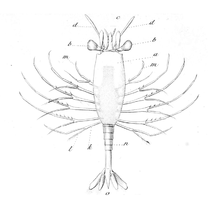Amphionidacea
| Amphionides reynaudii | |
|---|---|
 |
|
| Larva of A. reynaudii | |
| Scientific classification | |
| Kingdom: | Animalia |
| Clade: | Euarthropoda |
| Subphylum: | Crustacea |
| Class: | Malacostraca |
| Order: |
Amphionidacea D. I. Williamson, 1973 |
| Family: |
Amphionididae Holthuis, 1955 |
| Genus: |
Amphionides Zimmer, 1904 |
| Species: | A. reynaudii |
| Binomial name | |
|
Amphionides reynaudii (H. Milne-Edwards, 1833) |
|
| Synonyms | |
|
|
Amphionides reynaudii is the sole representative of the order Amphionidacea, and is a small (less than one inch long) planktonic crustacean found throughout the world's tropical oceans, the larvae mostly in shallow waters, and the adults at greater depth.
Amphionides grows to a length of 25 mm (1.0 in). Morphologically, Amphionides is somewhat unusual, with many body parts being reduced or absent. For example, it has only one pair of mouthparts – the maxillae – the mandibles and maxillules being vestigial.
Males and females differ in the form of the antennae, and also by the presence in males of the eighth thoracic appendage, albeit in a reduced form. This is the site of the male gonopore (the female's gonopore is on the sixth thoracic appendage). The first pleopod of the female is greatly enlarged and almost encloses the enlarged carapace. This is assumed to be a chamber in which the eggs are fertilised and retained until hatching. The more streamlined carapace and pleopods of the male make it more hydrodynamic, so fewer males are caught than females.
A. reynaudii has a cosmopolitan distribution in the world's tropical oceans. It is planktonic, inhabiting waters less than 100 m (330 ft) deep as a larva, but more often at depths of 700–1,700 m (2,300–5,600 ft) as an adult.
...
Wikipedia
